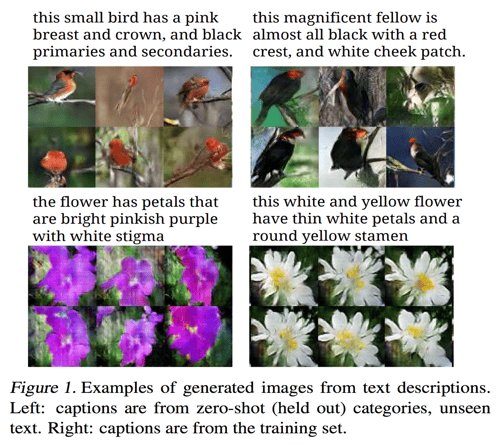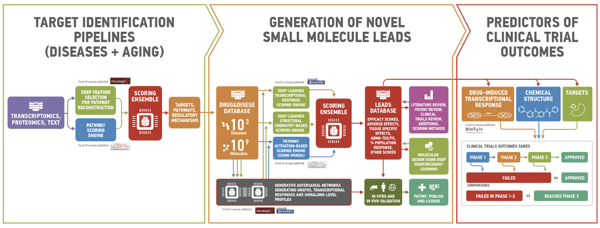|
What if we could generate novel
molecules to target any disease, overnight, ready for clinical trials?
Imagine leveraging machine learning
to accomplish with 50 people what the pharmaceutical industry can barely do
with an army of 5,000.
It’s a multibillion-dollar
opportunity that can help billions.
The worldwide pharmaceutical market,
one of the slowest monolithic industries to adapt, surpassed $1.1 trillion
in 2016.
In 2018, the top 10 pharmaceutical
companies alone are projected to generate over $355 billion in revenue.
At the same time, it currently costs
more than $2.5 billion (sometimes up to $12 billion) and takes over 10
years to bring a new drug to market. Nine out of 10 drugs entering Phase I
clinical trials will never reach patients.
As the population ages, we don’t have
time to rely on this slow, costly production rate. Some 12 percent of the
world population will be 65 or older by 2030, and “diseases of aging” like
Alzheimer’s will pose increasingly greater challenges to society.
But a world of pharmaceutical
abundance is already emerging.
As artificial intelligence converges
with massive datasets in everything from gene expression to blood tests,
novel drug discovery is about to get >100X cheaper, faster, and more
intelligently targeted.
One of the hottest startups I know in
this area is Insilico Medicine.
Leveraging AI in its end-to-end drug
pipeline, Insilico Medicine is extending healthy longevity through drug
discovery and aging research.
Their comprehensive drug discovery
engine uses millions of samples and multiple data types to a) discover
signatures of disease and b) identify the most promising targets for
billions of molecules. These molecules either already exist or can be
generated de novo with the desired set of parameters.
Insilico’s CEO Dr. Alex Zhavoronkov
recently joined me on an Abundance Digital webinar to discuss the future of
longevity research.
Just this week, Insilico announced
the completion of a strategic round of funding led by WuXi AppTec’s
Corporate Venture Fund, with participation from Pavilion Capital,
Juvenescence, and my venture fund BOLD Capital Partners.
What they’re doing is extraordinary
-- and it’s an excellent lens through which to view converging exponential technologies.
Case Study: Leveraging AI for Drug Discovery
You’ve likely heard of deep neural
nets -- multilayered networks of artificial neurons, able to ‘learn’ from
massive amounts of data and essentially program themselves.
Build upon deep neural nets, and you
get generative adversarial networks (GANs), the revolutionary technology
that underpins Insilico’s drug discovery pipeline.
What are GANs?
By pitting two deep neural nets
against each other (“adversarial”), GANs enable the imagination and
creation of entirely new things (“generative”).
Developed by Google Brain in 2014,
GANs have been used to output almost photographically accurate pictures from
textual descriptions (as seen below).
 Source:
Reed et al., 2016 Source:
Reed et al., 2016
Insilico and its researchers are the
first in the world to use GANs to generate molecules.
“The GAN technique is essentially an
adversarial game between two deep neural networks,” as Alex explains.
While one generates meaningful noise
in response to input, the other evaluates the generator’s output. Both
networks thereby learn to generate increasingly perfect output.
In Insilico’s case, that output
consists of perfected molecules.
Generating novel molecular structures
for diseases both with and without known targets, Insilico is pursuing drug
discovery in aging, cancer, fibrosis, Parkinson’s Disease, Alzheimer’s
Disease, ALS, diabetes, and many others.
Once rolled out, the implications
would be profound.
Alex’s ultimate goal is to develop a
fully-automated Health as a Service (HaaS) / Longevity as a Service (LaaS)
engine. Once plugged into the services of companies from Alibaba to
Alphabet, such an engine would enable personalized solutions for online
users, helping them prevent diseases and maintain optimal health.
But what does this tangibly look
like?
Insilico’s End-to-End Pipeline
First, Insilico leverages AI -- in
the form of GANs -- to identify targets (as seen in the first stage of
their pipeline below). To do this, Insilico uses gene expression data from
both healthy tissue samples and those affected by disease.
(Targets are the cellular or molecular
structures involved in a given pathology that drugs are intended to act
on.)
 Source:
Insilico Medicine via Medium Source:
Insilico Medicine via Medium
Within this first pipeline stage,
Insilico can identify targets, reconstruct entire disease pathways and
understand the regulatory mechanisms that result in aging-related diseases.
This alone enables breakthroughs for
healthcare and medical research. But it doesn’t stop there.
After understanding the underlying
mechanisms and causality involved in aging, Insilico uses GANs to ‘imagine’
novel molecular structures. With reinforcement learning, Insilico’s system
lets you generate a molecule with any of up to 20 different properties to
hit a specified target.
This means that we can now identify
targets like never before, and then generate
custom molecules de novo such that they hit those
specific targets.
At scale, this would also involve
designing drugs with minimized side effects, a pursuit already being worked
on by Insilico scientist Polina Mamoshina in collaboration with Oxford
University’s Computational Cardiovascular Team.
One of Insilico’s newest initiatives
-- to complete the trifecta, if you will -- involves predicting the outcomes of
clinical trials. While still in the early stages of
development, accurate clinical trial predictors would enable researchers to
identify ideal preclinical candidates.
That’s a 10X improvement from today’s
state of affairs.
Currently, over 90 percent of
molecules discovered through traditional techniques and tested in mice end
up failing in human clinical trials. Accurate clinical trial predictors
would result in an unprecedented cutting of cost, time, and overhead
in drug testing.
The 6 D’s of Drug Discovery
The digitization and
dematerialization of drug discovery has already happened.
Thanks to converging breakthroughs in
machine learning, drug discovery and molecular biology, companies like
Insilico can now do with 50 people what the pharmaceutical industry can
barely do with an army of 5,000.
As computing power improves, we’ll be
able to bring novel therapies to market at lightning speeds, at much lower
cost, and with no requirement for massive infrastructure and investments.
These therapies will demonetize and democratize as a result.
Add to this anticipated breakthroughs
in quantum computing, and we’ll soon witness an explosion in the number of
molecules that can be tested (with much higher accuracy).
Finally, AI enables us to produce
sophisticated, multitarget drugs. “Currently, the pharma model in general
is very simplistic. You have one target and one disease — but usually a
disease is not one target, it is many targets,” Alex has explained.
Final Thoughts
Inefficient, slow-to-innovate, and
risk-averse industries will all be disrupted in the years ahead. Big Pharma
is an area worth watching right now, no matter your industry.
Converging technologies will soon
enable extraordinary strides in longevity and disease prevention, with
companies like Insilico leading the charge.
Fueled by massive datasets,
skyrocketing computational power, quantum computing, blockchain-enabled
patient access, cognitive surplus capabilities and remarkable innovations
in AI, the future of human health and longevity is truly worth getting
excited about.
Rejuvenational biotechnology will be
commercially available sooner than you think. When I asked Alex for his own
projection, he set the timeline at “maybe 20 years — that’s a reasonable horizon
for tangible rejuvenational biotechnology."
Alex’s prediction may even be
conservative.
My friend Ray Kurzweil often
discusses the concept of “longevity escape velocity” — the point at which,
for every year that you’re alive, science is able to extend your life for
more than a year.
With a record-breaking prediction accuracy of 86 percent, Ray predicts
“it’s likely just another 10 to 12 years before the general public will hit
longevity escape velocity.”
How might you use an extra 20 or more
healthy years in your life? What impact would you be able to make?
Join Me
(1) A360 Executive
Mastermind: This is the sort of conversation I explore at my Executive
Mastermind group called Abundance 360. The program is highly selective, for
360 abundance and exponentially minded CEOs (running $10M to $10B
companies). If you’d like to be considered, apply
here.
(2) Abundance Digital
Online Community: I have also created a
Digital/Online community of bold, abundance-minded entrepreneurs called
Abundance Digital. This is my ‘onramp’ for exponential entrepreneurs –
those who want to get involved and play at a higher level. Click
here to learn more.
(3) Abundance Global
Events: This year, I’m expanding A360 into three key emerging global
markets: Central/South America (Rio de Janeiro, Brazil); Asia (Shanghai, China) and MENA (Dubai, UAE). If you’d like to join me, apply using the
links above.
|



No comments:
Post a Comment